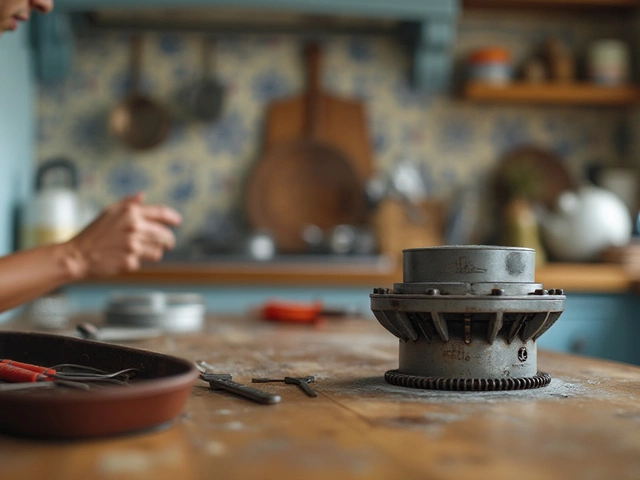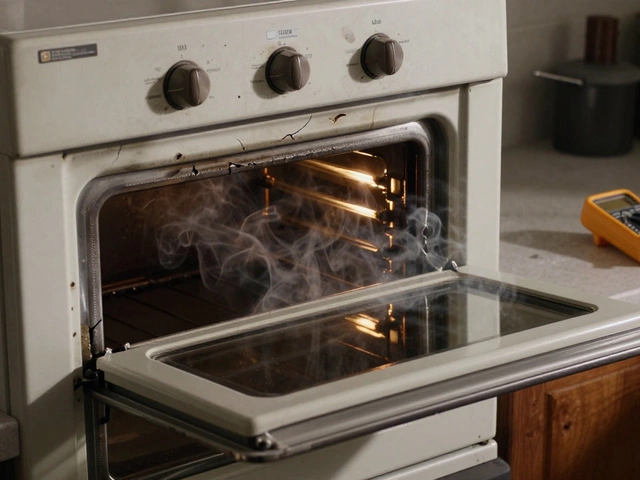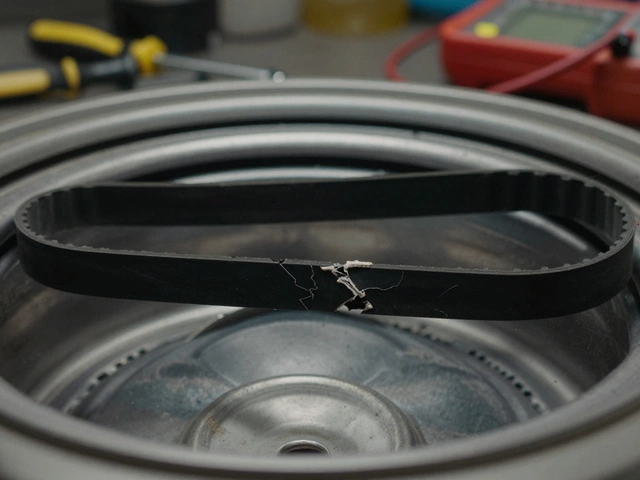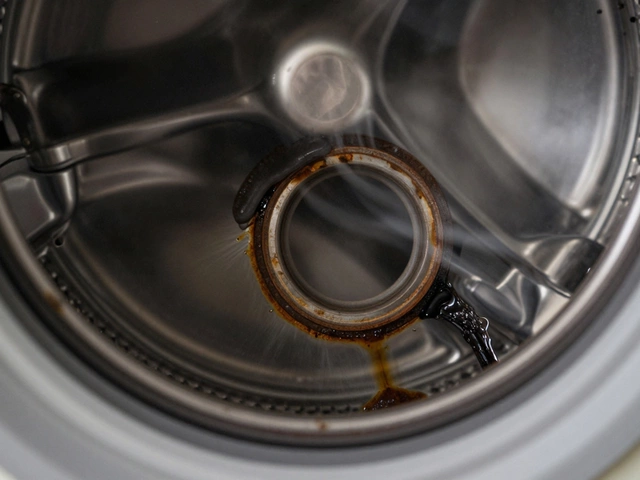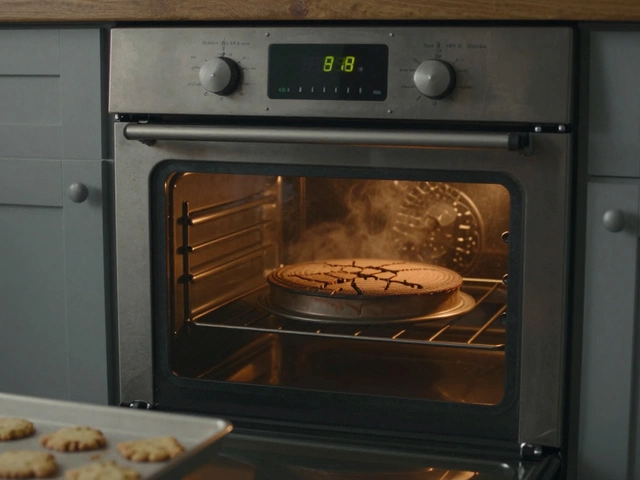Replacing the motor in your kitchen extractor fan can be daunting if you're not familiar with the process, but don't worry, this guide will help you through each step. A working extractor fan is vital for removing smoke, steam, and unwanted odors from your kitchen, ensuring a pleasant cooking environment.
Over time, the motor can wear out, leading to reduced performance or even complete failure. Recognizing the signs of wear and knowing how to replace the motor can save you from costly professional repairs.
Join me as we explore the tools required, safety precautions, and the clear steps to restore your extractor fan to its former glory, allowing you to enjoy fresh and clean air in your kitchen once more.
- Understanding the Role of the Extractor Fan Motor
- Signs of a Faulty Extractor Fan Motor
- Gathering Tools and Materials
- Step-by-Step Motor Replacement Process
- Safety Tips for DIY Repair
- Prolonging the Life of Your Kitchen Extractor Fan
Understanding the Role of the Extractor Fan Motor
The extractor fan motor is the unsung hero of kitchen ventilation, tirelessly working behind the scenes to ensure your cooking space remains fresh and free from lingering odors. In essence, the motor's primary duty is to power the fan blades, drawing in the airborne grease, smoke, and steam produced during cooking activities. Without this crucial component, any extractor fan would be rendered ineffective, leaving your kitchen atmosphere rather unpleasant. The motor achieves its task by converting electrical energy into mechanical energy, generating the necessary force to rotate the fan and expel unwanted air.
In modern households, kitchens are often the heart of the home, making it especially important for the environment to remain comfortable and odor-free. An effective extractor fan contributes significantly to this by keeping air circulation active and managing humidity levels, reducing the growth of molds and bacteria. When considering the home appliance maintenance aspect, replacing or repairing a worn-out fan motor can help maintain this delicate balance. A robust motor ensures that the air quality remains adequate and that your cooking environment is as pleasant as can be.
The longevity and performance of an extractor fan motor are influenced by several factors, including the type of fan and its usage pattern. Various fans, such as range hoods or over-the-stove vented models, come equipped with different motor specifications suited to varying kitchen arrangements and usage rates. It's imperative to understand these differences when considering a potential extractor fan motor replacement. Additionally, motors are designed to handle particular speeds and loads. As such, opting for a sub-par motor may shorten the lifespan of the entire unit. A professional tip: regular cleaning of the fan blades reduces the stress on the motor, allowing it to function optimally and extending its overall life.
Expert technician John McAdam once stated, "The motor is the extractor fan's powerhouse. Keeping it in top shape is vital for kitchen safety and efficiency."Being diligent about inspecting signs of wear, such as unusual noises or reduced air movement, can provide early warning of impending fan motor failure, allowing for timely interventions. By being proactive, households can avoid inconvenient breakdowns and ensure the continued functionality of their kitchen extractor fan.
Examining some data, it's easy to see why extractor fan motors play such a crucial role. Studies indicate that efficient kitchen ventilation can reduce indoor air contamination by up to 60%, a testament to the importance of a well-functioning fan system. With this understanding, every homeowner can appreciate not just the motor's role but also the need to address any signs of malfunction promptly. Practical knowledge about this mechanism can make a substantial impact on indoor air quality and, by extension, the health and comfort of everyone at home.
Signs of a Faulty Extractor Fan Motor
Recognizing the symptoms of a faulty extractor fan motor can be the first step in restoring your kitchen's efficiency. Often, issues with the fan motor manifest in distinct and noticeable ways. One of the telltale signs is a sudden increase in noise levels. If your kitchen fan begins to whir or hum much louder than usual, it's not just an environmental soundtrack to your cooking adventures but a clear red flag. This noise often means the motor is straining to run and may soon give out.
A sluggish motor is another indication that things aren't running smoothly. If your fan seems to struggle to spin at its regular speed, this could be attributed to a worn-out motor coil or internal obstructions. It's also common to notice unusual vibrations. These vibrations could likely loosen other components of your kitchen fan over time, risking further damage and inefficiencies. Watch out for this movement, as it might indicate the motor is out of balance or losing its structural integrity.
The motor's role in creating airflow can't be understated, so when a fan stops adequately clearing steam or smoke from your kitchen, it's often an issue with the motor. Poor airflow can mean the motor isn't running at full capacity or that it's nearing the end of its operational life. In some cases, you might see the fan blades spinning but notice that steam and odor linger more persistently in your kitchen space than they used to.
Another sure sign of a problematic motor is overheating. You might touch the casing of your extractor to find that it feels warmer than usual, or you may even smell a burnt odor. This often indicates that the motor is overworking or about to fail. According to experts at the International Association of Electrical Inspectors, "An overheated motor should never be ignored, as it can lead to catastrophic failure and poses a fire hazard."
Poor maintenance is a leading factor in the premature failure of home appliance motors," an article published by Home Appliance Magazine noted, adding that regular care can prevent most operational issues.
Yet, some subtler signs, like erratic shutting on and off or even simply being unresponsive, can announce themselves out of nowhere. Sometimes it feels like your kitchen fan repair list is manageable until this happens. In these cases, check for tripped circuit breakers or thermal cut-outs, but if the problem persists, you're likely dealing with a malfunctioning motor.
Being attentive to these symptoms can save you time and money down the road. Initiating a timely extractor fan motor replacement can help ensure that your kitchen remains a comfortable and functional workspace, devoid of unwelcome smells or excess moisture.

Gathering Tools and Materials
Embarking on a DIY project like replacing an extractor fan motor requires careful preparation and the right set of tools. Just like any mission, having the proper equipment makes the task not only easier but also more enjoyable. So, before diving into the nitty-gritty of dismantling your kitchen fan, let's ensure your toolkit is up to the task. Remember, the goal is to make each step smooth and efficient, reflecting a well-planned effort.
The first item on your list should be a screwdriver set since extractor fans are commonly secured with various screws. The essential types include Phillips and flat-head screwdrivers, but due to some brand variations, it might be handy to have a Torx screwdriver as well. It's wise to have a range of sizes—because you never know when you'll encounter that one stubborn screw that needs a specific tool size. A power drill might come in handy but always try loosening screws manually initially to avoid strippage.
Next, a voltage tester is critical because safety comes first when dealing with any electrical appliance. It helps confirm that the electricity is indeed disconnected, safeguarding you against accidental shocks. Investing in a digital multimeter is also a good idea if you frequently do home repairs, as it provides more comprehensive data about your fan's electrical components, ensuring your new motor matches the required specifications.
Wire strippers and pliers will also be useful. Often, replacing the motor involves disconnecting wires, and these tools make the process quicker and neater. Keep cable ties handy for re-bundling wires once you've connected the new extractor fan motor. A soft cloth or an old towel is recommended too, for cleaning accumulated grease or dust inside the hood during the replacement process. Let's not forget a flashlight—kitchen lighting might not always be adequate, especially when peering into dim corners of the extractor casing.
Interestingly, did you know that motor failure is one of the most common issues in kitchen extractors? A survey by a well-known home appliance repair service indicated that around 40% of kitchen extractor breakdowns are due to motor complications, reinforcing the importance of this article's repair guidance.
A seasoned technician from the same service once remarked, "Keeping your tools organized and within reach can cut your repair time in half." So, maintain an orderly workspace—your tools should be laid out neatly, ready for when you need them.
Lastly, gather materials like replacement fan belts if needed, and ensure you have the correct replacement motor. It pays off to double-check the model number and the compatibility of the new motor with your existing system. Manufacturers often have specifications that are critical for ensuring the motor operates effectively within your fan's design parameters. As you cross-check parts, note that some models have proprietary designs that require specific parts, which can only be sourced from the original manufacturer.
Here's a small tip: if you're unsure whether your new motor is an exact fit, reach out to your manufacturer’s customer service for more clarification. Some companies even provide diagrams or over-the-phone guidance to verify features—a proactive step that saves time and hassle. Now that your toolbox is ready, you're one step closer to successfully completing your kitchen extractor fan motor replacement project.
Step-by-Step Motor Replacement Process
Deciding to replace your kitchen extractor fan motor yourself can be a rewarding experience, especially if you enjoy a bit of DIY around the house. Before you begin, you'll need to gather some basic tools and a replacement motor suited to your model. The most common tools needed are a screwdriver set, pliers, and sometimes a socket wrench. It's crucial to ensure you've also got the right extractor fan motor replacement part. Check your model number and get the manufacturer's recommended motor to avoid compatibility issues. Once you're ready to go, it's vital to ensure safety is your top priority. Make sure to disconnect the fan from the power supply to prevent any accidents. You might also consider wearing gloves and safety goggles for extra protection.
The most exhilarating first step is often getting access to where the motor resides. Begin by removing the fan cover. This usually involves unscrewing several screws depending on your fan model. Gently lift away the cover, making sure not to damage or lose any screws. With the cover off, you should have a clear view of the internal components. Take your time to familiarize yourself with the layout, noting how and where the wires connect to the current motor. It's often helpful to snap a few photos or jot down notes for reference later. This simple precaution can save you a lot of time and headache during reassembly.
"When it comes to home appliance repair, preparation is key," remarks Charlie Day, an experienced electronics technician. "Having a clear understanding of each step beforehand can make the process smooth and rewarding."
Next, you're ready to remove the old motor. Carefully disconnect any wiring attached to the motor, noting where each wire connects. Some motors are mounted with bolts or screws, so you'll need the appropriate tools to release them. Once free, gently remove the kitchen fan motor from its housing. With the motor out, it's a good moment to clean the surrounding area. Dust and grime can accumulate over time, potentially hindering the performance of the new motor. Take a soft cloth or a mild cleaning solution to wipe away any debris.
With everything prepped and pristine, it's time to install the new motor. Position the replacement motor in the same orientation as the old one, ensuring a snug fit. Secure it with the screws or bolts you removed earlier, but avoid over-tightening. Reconnect the wiring, making sure each connection matches your earlier notes or photos. This often involves matching wire colors, but always double-check using the fan's manual if you're unsure. It's a perfect time to ensure all connections are secure and nothing is left hanging loose.
Finally, before closing up, test the fan to ensure all is working as expected. Reconnect the power and flick the switch to observe the motor in action. Listen for any abnormal sounds or vibrations, as these could indicate improper installation. If everything seems in order, you can reattach the fan cover and secure it tightly. Stand back and admire your handiwork; you've successfully tackled a DIY extractor fan fix like a pro.
If you feel overwhelmed at any point or encounter an issue that seems too complex, don't hesitate to consult your fan's manual or seek professional help. It's crucial to ensure home safety always comes first.

Safety Tips for DIY Repair
Embarking on a DIY journey, especially one that involves electrical components like a kitchen fan repair, requires a bit of caution. Safety always comes first, and this is even more critical when working around electricity. Understanding the potential risks and ensuring you're adequately protected can make all the difference between a successful repair and an unfortunate incident.
The first critical step is ensuring the power supply to your extractor fan is completely disconnected. This means not just switching it off, but also removing the corresponding fuse or flipping the circuit breaker. Even a brief accidental activation can cause severe injury. Before you start any home appliance maintenance, confirm that the power is truly off with a voltage detector. It's a small investment, but it could prove to be vital.
Once you're confident that everything is safe, it's important to work in a well-lit and spacious area. Good lighting not only helps prevent mistakes but also reduces the risk of accidents. Keeping your workspace tidy is equally important. Tools and parts scattered around can become tripping hazards or distractions. Remember, preparation is key to a successful repair.
Consider the right attire for the job. Wear clothes that fit well and are not too loose to avoid getting caught in any moving parts. Protective gear should not be overlooked either. Safety goggles can protect your eyes from dust or debris, while gloves can offer a layer of protection against sharp fan blades or other hazards.
Another crucial factor is to have a clear understanding of the extractor fan's manual. While it may seem like tedious reading, it contains valuable information about the specific model you are working with. The manual often includes insights into what tools you might need and the order of disassembly steps, reducing the likelihood of errors. If the manual is unavailable, look online for a PDF version from the manufacturer's website.
To add an expert touch, meticulous labeling of parts as they are removed can make reassembly much smoother. Consider taking photos as you go along, creating a visual reference to avoid confusion later. A quote from a well-known electrical engineer highlights this approach:
"When dismantling any device, taking clear photos every step of the way can save hours of frustration during reassembly."
Maintaining the extractor fan motor replacement project within your skillset is also important. For complex models or extravagant ventilation systems, calling in a professional might be the safer option. Remember, acknowledging the limits of your expertise is in itself an essential safety measure. This will ensure you’re tackling repairs that you can handle without putting yourself in unnecessary danger.
Prolonging the Life of Your Kitchen Extractor Fan
Maintaining your kitchen's extractor fan in tip-top condition can significantly extend its lifespan and keep your kitchen environment clean and fragrant. A few simple practices can help you achieve this goal, ensuring your fan operates efficiently for years. One of the primary actions you can take is regular cleaning. Dust and grease can accumulate on the fan blades and motor, obstructing airflow and causing the motor to work harder than necessary, which may lead to premature failure. To tackle this, make it a habit to clean the filter at least once a month. If your fan's model has washable filters, remove them carefully and clean them thoroughly with warm, soapy water. Reinstall them only after they are completely dry. If you have disposable filters, replace them as per the manufacturer's instructions.
"Proper maintenance is the cornerstone of any appliance's longevity," says John Parker, a renowned home appliance expert. "The more care you give your extractor fan, the longer it will serve you without any hiccups."
Apart from cleaning, regular checks on the motor's operation can alert you to early signs of wear or failure. If you notice any unusual noises or your fan's performance seems lackluster, it might be time to investigate further. When conducting these checks, ensure that the power supply is safely turned off to prevent any accidents. Use these opportunities to tighten any loose screws and make sure all components fit snugly. Inspecting the ductwork can also prevent issues; blockages or leaks can cause your kitchen fan to struggle, reducing effectiveness and increasing wear. Consider replacing or upgrading parts that seem worn out or inefficient to keep your fan in prime condition.
Ventilation is another aspect you shouldn't overlook. Ensure the area around your kitchen is well-ventilated, which helps to disburse the heat and humidity your fan extracts. This not only boosts its efficiency but also reduces the burden on the motor. When cooking, try to match your extractor fan's speed with the level of culinary activity. You don't always need to run the fan at full speed, which can overtax the motor. Operating at lower settings whenever possible can conserve energy and reduce wear, extending the life of your fan. Another good practice is turning your fan on before cooking begins, which helps it control moisture and odors more effectively from the get-go.
It is also critical to ensure the fan receives a steady supply of electricity and is not subjected to power surges, which can damage its internal components. If you live in an area prone to electrical fluctuations, consider investing in a surge protector. Prioritize replacing worn-out wiring or faulty circuits, which could distress the motor or even lead to dangerous situations. Keep a regular check on the power switch to ensure it is functioning well and not causing intermittent operation.
These deliberate efforts can significantly extend the durability of your kitchen extractor fan, making it a dependable companion in your cooking adventures. By incorporating regular maintenance routines and being mindful of its operation, you can enjoy a functional and efficient appliance longer, reducing the need for costly repairs or replacements in the future. Your extractor fan will thank you, and so will your nose!




